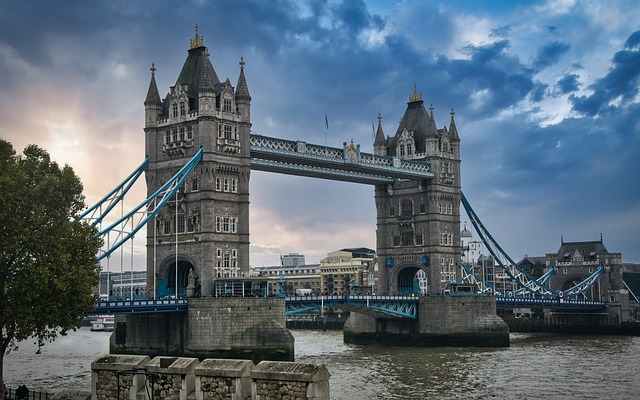Located in the Denizli province in southwestern Turkey, Pamukkale is one of the world’s most impressive and unique tourist destinations. This astounding place, whose name means “cotton castle” in Turkish, is famous not only for its dazzling white travertine terraces but also for its rich and fascinating history that dates back millennia.
Pamukkale is a site where nature and history intertwine perfectly. The hot springs that flow from the hilltop have shaped a landscape that looks like something out of a dream, creating travertine formations that dazzle visitors with their bright whiteness. But it’s not just the natural beauty that attracts travelers; the ruins of the ancient city of Hierapolis, situated right next to the terraces, transport us to a time when this place was a thriving cultural and spiritual center.
In this article, we’ll take you on a tour of Pamukkale, exploring not only its natural features but also its history, how to get there, and some useful tips to make your visit as enjoyable as possible. Get ready to discover a destination that will surely take your breath away and earn a special place on your list of favorite travels.
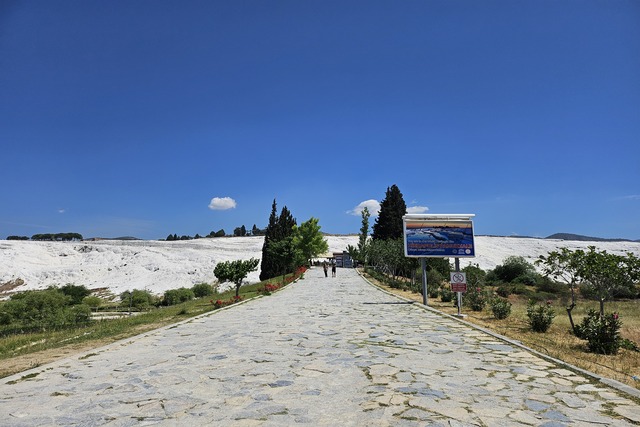
How to Get to Pamukkale
Pamukkale is well connected and accessible from several major cities in Türkiye. The city of Denizli, located about 20 kilometers away, is about 3-4 hours drive from Izmir, Antalya or Fethiye. Denizli has an airport and a train station, making it easy for tourists to access.
However, if you are located in Istanbul and don’t want to miss this must-see destination, you should know that visiting it is possible and very easy. In the historic center of Istanbul, you’ll find thousands of all-inclusive day tours, but if you’re an adventurous traveler who likes to explore freely and enjoy every second, we have some tips for you. From Istanbul’s airports, direct flights to the city of Denizli depart early every morning. The flight takes 1 hour and costs around 33 euros. However, we advise you to keep an eye on flight websites, as they often have great offers depending on the season.
Once you arrive at the airport, you have several options. The first is to hire a taxi if you prefer private transfers. We recommend negotiating with the driver beforehand. Alternatively, you can take one of the buses heading to Pamukkale, which costs around 7.21 euros (2024 price) and takes 40 minutes to reach your final destination. Once you arrive at the Cotton Castle, you will find the hotel and restaurant area, where you can enjoy a delicious traditional Turkish breakfast and buy souvenirs. We also suggest buying water and snacks from the shops outside, as prices are significantly higher within the Cotton Castle.
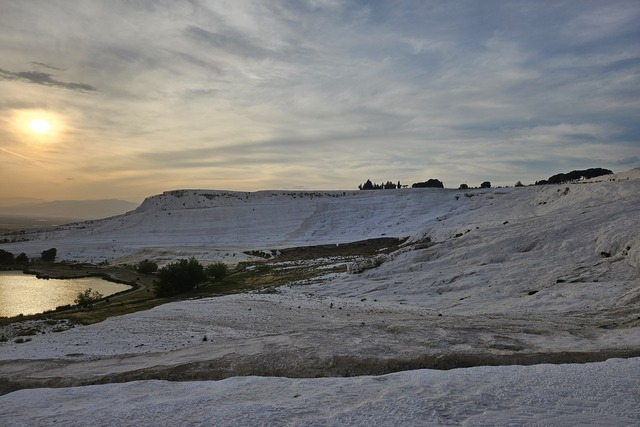
What is the entrance fee for Pamukkale?
The entrance ticket for Pamukkale (Cotton Castle) is around 30 euros or 33 USD, and it includes a visit to the ancient city of Hierapolis. If entering Cleopatra’s pool is one of your plans, you should know that its price is independent and is 6 euros.
As we told you before, you can buy your tickets directly in Pamukkale, however we share some options that we thought were great and even more so if you are not staying in Denizli or Pamukkale, but like many you do not want to miss out on this wonderful experience.
- From Antalya/Kemer: Pamukkale & Hierapolis Day Trip w/Meals Book here
- Side:Pamukkale and Salda Lake With Unique Natural Beauties Book here
- From Kusadasi: Pamukkale & Hierapolis Guided Tour with Lunch Book here
What to do in Pamukkale?
The Travertine Terraces
The terraces of Pamukkale were formed over thousands of years by the mineral-rich water flowing from the area’s hot springs. As the hot water cools, calcium carbonate is deposited, creating bright white formations that look like frozen waterfalls. These natural pools, with their turquoise water, offer an unparalleled visual experience and a perfect setting to relax and enjoy nature.
The Thermal Waters
The thermal waters of Pamukkale have been famous for their healing properties since ancient times. With temperatures ranging from 35 to 100 degrees Celsius, these waters contain beneficial minerals believed to alleviate various ailments, from skin problems to rheumatic diseases. Visitors can immerse themselves in some of the natural pools and feel the warmth and comfort they provide.
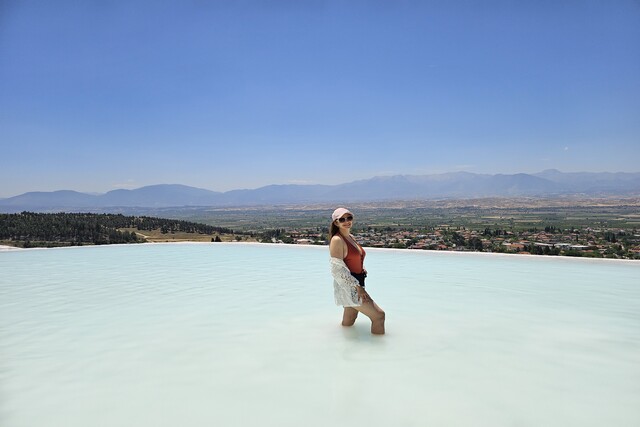
The Ancient City of Hierapolis
Just above the terraces of Pamukkale lies the ancient city of Hierapolis, a fascinating archaeological site founded by the Phrygians in the 2nd century BC. Hierapolis flourished during the Roman period, becoming an important cultural and religious center. Visitors can explore the ruins of theaters, temples, Roman baths, and the necropolis, which is one of the largest in Anatolia.
The Hierapolis Museum
Within the Hierapolis complex, there is a small but interesting museum that houses artifacts discovered in the area. Here, visitors can learn more about the region’s rich history and admire sculptures, sarcophagi, and other ancient objects dating from various historical periods. Admission to this magical museum is included in the admission ticket to Algodon Castle.
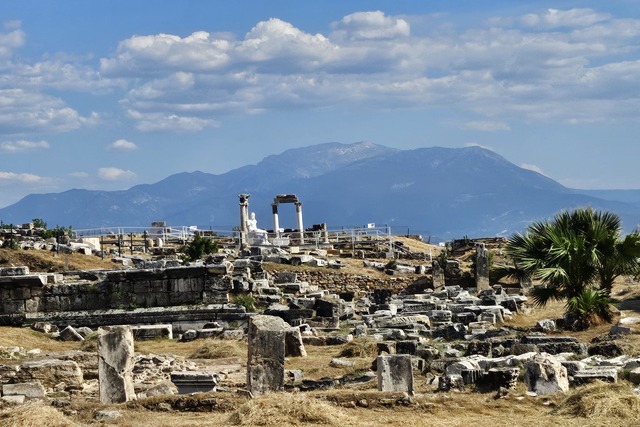
Cleopatra’s Pool
Within the Pamukkale and Hierapolis complex lies the famous Cleopatra’s Pool, also known as the Antique Pool. This spot is a must-visit for those exploring the area, not only for its mineral-rich thermal waters but also for the legend and history surrounding it. Cleopatra’s Pool is named in honor of the legendary Egyptian queen Cleopatra, although there is no concrete historical evidence that she visited the site. However, the legend holds that Mark Antony, in love with Cleopatra, gifted her this pool, and the queen enjoyed bathing in these thermal waters.
What makes Cleopatra’s Pool unique is its natural setting and the archaeological remains surrounding and within it. The thermal water springs up at a temperature of approximately 36 degrees Celsius, making it an ideal place to relax and enjoy a warm and comforting bath.The pool is filled with columns, capitals, and other remains from the ancient city of Hierapolis that fell into it during an earthquake. This creates a truly unique bathing experience, as you can swim among these ancient artifacts while enjoying the healing properties of the water.
Cleopatra’s Pool waters are rich in minerals such as calcium, magnesium, and bicarbonate. These minerals are considered beneficial for the skin, muscles, and joints, and are believed to help alleviate problems such as rheumatism, muscle pain, and various skin conditions. Cleopatra’s Pool is a must-have experience for any visitor to Pamukkale. Immersing yourself in its crystal-clear waters, surrounded by historical remains, allows you to imagine what it must have been like in ancient times. The serene atmosphere and beauty of the place make it a highlight of any visit to this region.
Remember that entry to Cleopatra’s pool has an independent cost (6 euros), so save money and enjoy an unbeatable experience, where you can also enjoy the typical cuisine of the region very close to the pool.
Booking.comAnother activity that is highly recommended to do in Pamukkale is without a doubt traveling by Balloon, this experience is truly unique, because you will be able to see the beauty of the Algodon Castle from the heights, where this panoramic view is definitely unmatched. Below we leave you the best tours that include the balloon ride so you don’t miss any details.
- Pamukkale: Hot Air Balloon Flight with Flight Certificate Book here
- From Marmaris: Pamukkale Balloon Flight Day Trip with Lunch Book here
- Antalya: Pamukkale Tour with Hot Air Balloon and Meals Book here
- Alanya, Side, Antalya: Sunrise Balloon Tour in Pamukkale Book here
Traveler tips
Proper footwear: Since you will be walking through ruins, it is important that you wear comfortable footwear. Be careful, keep in mind that when you enter the Traventines terraces, you will be asked to take off your shoes, to protect the area, so we recommend wearing a double pair of socks and walking very carefully since there are slippery areas.
Visiting Hours: To avoid crowds and intense heat, it is recommended to visit early in the morning or at dusk.
Respect the site: remember that Pamukkale is a protected site. Avoid damaging the terraces and follow the instructions of the park rangers.
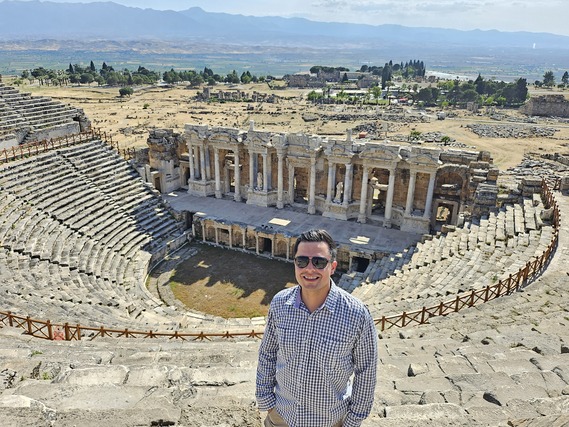
In conclusión Pamukkale is much more than a natural wonder; it is a testament to the interaction between nature and history. This “cotton castle” offers a unique experience where you can walk on the white travertine terraces, soak in the healing thermal waters, and explore the ancient ruins of Hierapolis. Every step you take in Pamukkale connects you with centuries of history and invites you to enjoy the serenity and beauty of this incredible place.
For any traveler, a visit to Pamukkale is an opportunity to contemplate one of the world’s most unique landscapes and immerse yourself in a rich and fascinating history. It is a destination that leaves a lasting impression and will undoubtedly enrich your travel experience in Turkey. If you are planning your next trip, make sure to include Pamukkale in your itinerary; we promise you won’t regret it.
